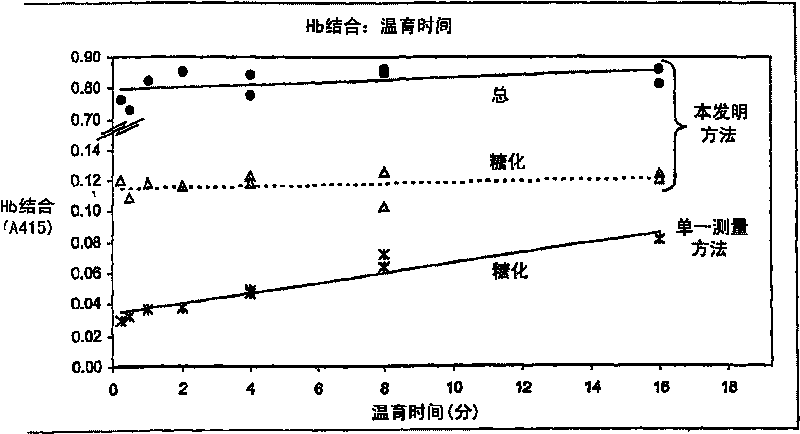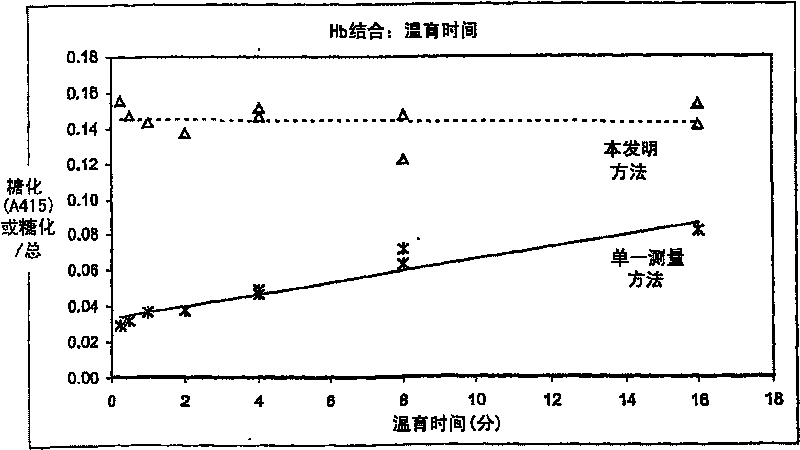Method and devices for quantitation of glycated protein
A protein and saccharification technology, which can be used in measurement devices, color/spectral property measurement, instruments, etc., and can solve problems such as changes in results
- Summary
- Abstract
- Description
- Claims
- Application Information
AI Technical Summary
Problems solved by technology
Method used
Image
Examples
Embodiment 1
[0091] Preparation of borated solid support matrix
[0092] According to a preferred aspect of the detection method of the present invention, a solid support matrix suitable for strip construction can be obtained by covalently attaching a boronate derivative, m-aminophenylboronate, to a carboxycellulose-based material using conventional attachment chemistries. .
[0093] Material
[0094] 1. Solid carrier matrix: cellulose-based solid (Sartobind C membrane Sartoricus) to which carboxylic acid groups are covalently attached.
[0095] 2. EDC (1-ethyl-3-(3-dimethylaminopropyl) carbodiimide hydrochloride) (Pierce)
[0096] 3. Borate derivative meta-aminoboronic acid (Sigma-Aldrich)
[0097] 4. Buffer: 0.1M MES buffer, pH6.5
[0098] method
[0099] 46.7 mg of m-aminophenylboronic acid was dissolved in 25 ml of 100 mM MES buffer. The pH was readjusted to 6.5 after the boric acid was dissolved. 28.9 mg of EDC was dissolved in MES-boric acid solution. Immerse the solid ...
Embodiment 2
[0103] Effect of variable incubation time
[0104] A single measurement test with the borated support of Example 1 ("Single Measurement") was compared with the method of the present invention to determine the effect of variable incubation times on the concentration results obtained by each method.
[0105] The following tests were performed to compare the two methods. In the single assay test, blood lysates from non-diabetic and diabetic individuals were treated with 50 mM Mg ++ 500 mM ammonium acetate buffer (pH=9.5) was diluted 1:1, and then the samples were contacted with the borated solid support matrix prepared in Example 1 for different time periods. After incubation, the borated solid support was rinsed with ammonium acetate buffer (pH=9). Glycated hemoglobin was eluted with tris buffer (pH=8.0) containing 200 mM sorbitol. The absorbance of the eluate was measured at 415 nm.
[0106] In a second test corresponding to the method of the present invention, blood lysa...
Embodiment 3
[0111] Effect of pH on Binding
[0112] The pH of the buffer affects the amount of hemoglobin bound to the borated carrier. If the pH is low, both glycated and non-glycated hemoglobin are bound, and if the pH is high, only glycated hemoglobin will be bound. Figure 4 Binding of hemoglobin to carboxycellulose membranes (absence of boronic acid groups) was shown following the test procedure described in Example 2. In the absence of boric acid, the membrane loses its ion-binding capacity for hemoglobin between pH 6 and 7.
[0113] Figure 5 The hemoglobin and human serum albumin binding properties of carboxycellulose supports with added boronic acid groups prepared as described in Example 1 are shown. Binding of proteins occurs at lower pH due to the negatively charged carboxyl groups. The proteins bound at higher pH due to phenylboronic acid were glycated proteins in the sample.
PUM
 Login to View More
Login to View More Abstract
Description
Claims
Application Information
 Login to View More
Login to View More - R&D
- Intellectual Property
- Life Sciences
- Materials
- Tech Scout
- Unparalleled Data Quality
- Higher Quality Content
- 60% Fewer Hallucinations
Browse by: Latest US Patents, China's latest patents, Technical Efficacy Thesaurus, Application Domain, Technology Topic, Popular Technical Reports.
© 2025 PatSnap. All rights reserved.Legal|Privacy policy|Modern Slavery Act Transparency Statement|Sitemap|About US| Contact US: help@patsnap.com



